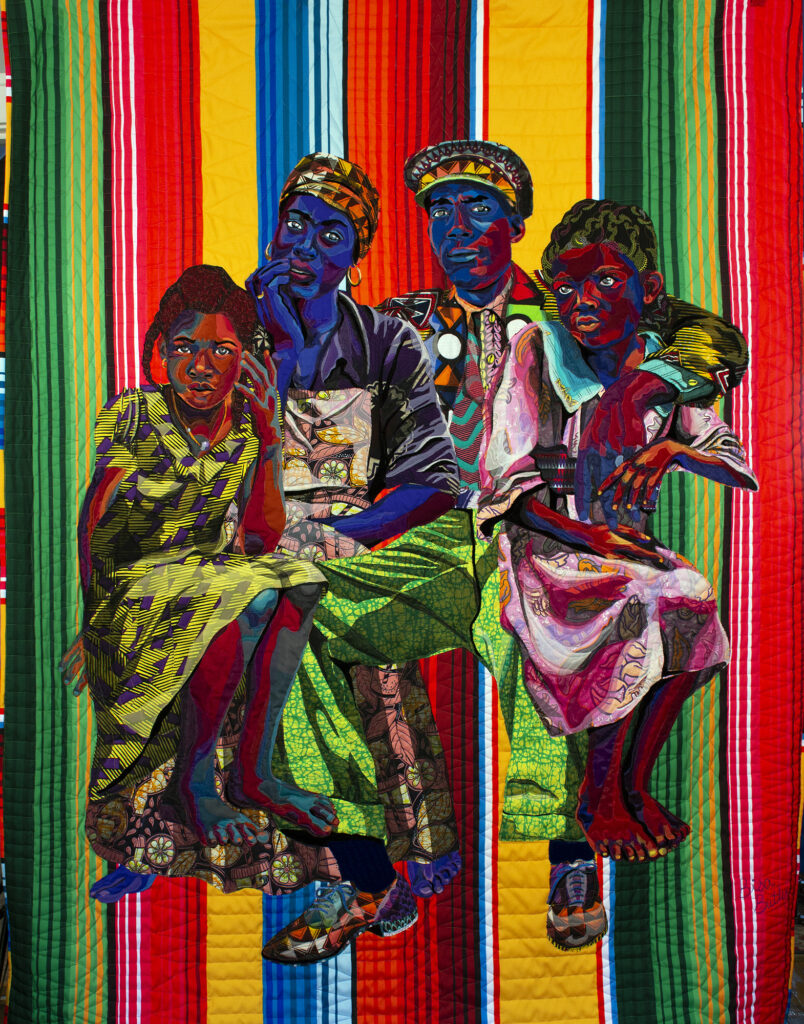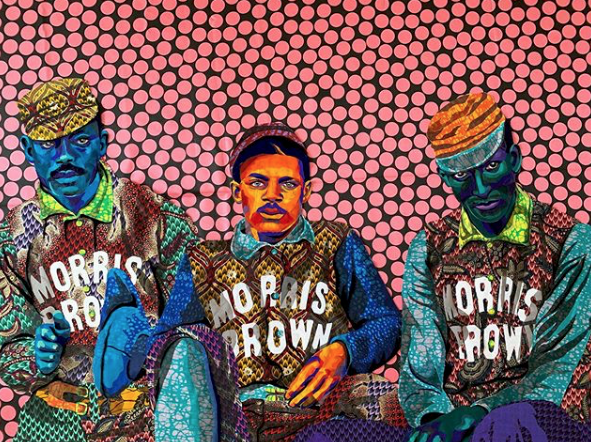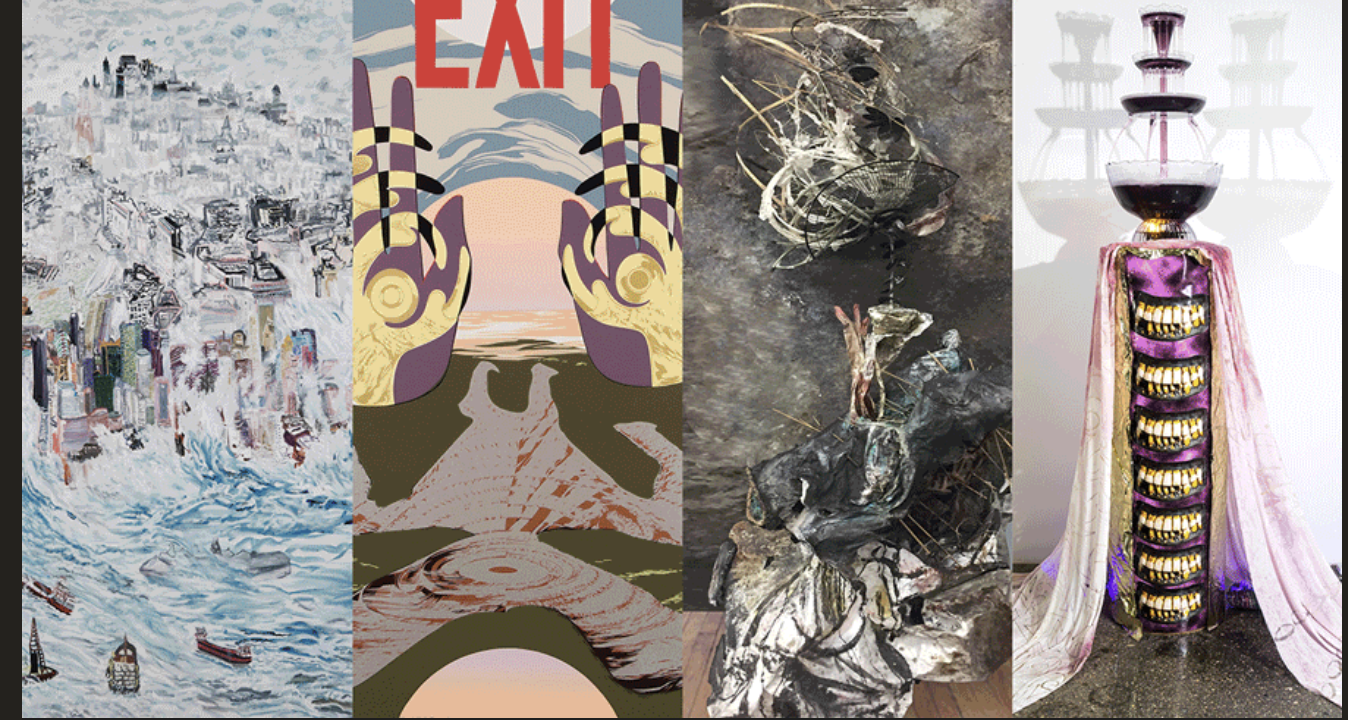Above: To Truth and God, The Morris Brown College motto. Inspired by a photo of their baseball team taken in 1899.
Cotton, silk, wool and velvet ,
12.5’ x 10’
This is a excerpt from an article written for Sugarcane Magazine’s 4th issue by Halima Taha.
More than 80,000 people converge annually upon Miami during the first week in December in pursuit of fine art from leading galleries that represent artists from all over the world. They expect to see art from modern and contemporary masters, as well as discover a new generation of emerging stars. With so many ideas, themes and media to digest, it is not unusual for art devotees or professionals to experience visual fatigue throughout the week and to overlook new discoveries within the fair.
The first time I saw the work of Bisa Butler was in Miami at the Pulse Art Fair during Art Basel. On this auspicious day, destiny restrained me from missing this distinct talent. When I turned toward the exit, I was immobilized by a series of large, phenomenally intricate quilts with bright patterns and textured fabrics, striped into cloth collages, capturing decisive moments in the lives of women, men and children. The subjects were welcoming with recognizable familiarity, while possessing a surrogate presence.
The faces and bodies were beckoning participation in their celebratory moment of joy, dignity, beauty and family. The most arresting quality of these quilted images was the way so many similarities in structured form seamlessly led to a compelling and unique aesthetic.
Geometry is integral to quilt making, but when skillfully combined with robust fabric, hypnotic collage and scintillating colors, Butler bends time and place into bejeweled, prismatic portraits. Within this scope, she has repeatedly earned a place among the “top picks” at exhibitions such as the Pulse Art Fair and the Chicago Expo.

Cotton, wool, silk, and velvet
Quilted and appliqué
85” x 65”. Photo by Ian Rubinstein of Claire Oliver Gallery
Previously, Butler was a high school art teacher supporting her art practice like her favorite expressionist painter, Alma Thomas (1891-1978), who herself followed the tradition of many noted artist/ teachers who elevated the awareness of the African American art canon, including James Porter (1905-1970), Dr. Samella Lewis (b. 1924) and David Driskell (b. 1931).
These thought leaders nurtured the development of several generations of talented artists and critical thinkers from Historically Black Colleges and Universities (HBCU). Although Butler did not study directly with Dr. Samella Lewis or David Driskell she, like many Howard University freshman, took a mandatory Black Arts course, which required reading scholarship that validated and recorded the importance of black cultural production in the U.S.
Among the scholars were Dr. Alain Locke, who helped launch black modernism by encouraging black artists during the Harlem Renaissance to look to Africa, instead of Europe for inspiration, hence the moniker, “Father of the Harlem Renaissance.’’ James Porter’s classic, first art-history book about black artists, Modern Negro Art, with Dr. Samella Lewis’ Art: African American, and David Driskell’s Two Centuries of Black American Art provided solid footing for every art student at the nation’s top HBCU colleges. Most American art history curricula are incomplete without exposure to these seminal texts.
In addition, the poetry of Sterling Brown, Gwendolyn Brooks, Amiri Baraka and Nikki Giovanni were discussed with regular critiques and studio visits from several mid-career and established artists including: Elizabeth Catlett (1915-2012), Lois Mailou Jones (1905-1998), Sam Gilliam (b. 1933), Frank Smith (b. 1935), Ernie Barnes(1938-2009) and Hale Woodruff (1900-1980), to provide insight, encouragement and practical knowledge.
Emphasizing the discipline and value of an artist’s work ethic, Hale Woodruff asserted, “It‘s very important to keep your artistic level at the highest possible range of development while making your work convey a telling quality in terms of what we are as a people.”
Butler was inspired by Elizabeth Catlett’s strong forms and figures. In the tradition of the academy, she duplicated Lois Mailou Jones’ Ubi Girl because she was fascinated by her realistic figuration and flat graphic backgrounds that looked both modern and ancient.
Howard University’s time-honored tradition of sharing experiential wisdom continues with a recent visit by contemporary artist, Mark Bradford.
As an art student, Butler had the good fortune to study under the tutelage of Jeff Donaldson, former dean of Howard University’s Fine Arts Program, and one of the first five members of AfriCOBRA (African Commune of Bad Relevant Artists) with Jae Jarrell, Wadsworth Jarrell, Barbara Jones-Hogu and Gerald Williams. Additional members included Nelson Stevens, Napoleon Jones-Henderson, Carolyn Lawrence, Frank Smith, James Phillips and Robert Paige.
This artist collective emerged from the south side of Chicago in 1968. The origin of this group had roots in the Organization of Black American Culture (OBAC), which was committed to finding ways to use art to address various social and cultural concerns affecting the African American community in the 1960s.
In 1967, many in this group participated in the completion of OBAC’s monumental 20-by-60-foot mural in Chicago’s Bronzeville neighborhood called the Wall of Respect. This infamous mural was composed of a montage of black heroes and heroines whose ideas and work were pivotal to African American history. Notable images included W.E.B. Dubois, Marcus Garvey, Harriet Tubman, Nat Turner, Gwendolyn Brooks, Muhammad Ali, Elijah Muhammad and Aretha Franklin.
The Wall of Respect inspired a black mural tradition that continues today and spawned many other artistic movements, including AfriCOBRA, which helped shape the Black Arts Movement.
The significance of the Wall of Respect was that it affirmed that black facial features were beautiful, which was important because of the devasting impact of Post Traumatic Slave Syndrome (PTSS), which describes a set of behaviors, beliefs and actions associated with or related to multi-generational trauma experienced by African Americans that include, but are not limited to undiagnosed and untreated Post Traumatic Stress Disorder (PTSD) in enslaved Africans and their descendants.

Cotton, silk, wool and velvet
Quilted and appliqué 72”X 53”. Photo by Ian Rubinstein of Claire Oliver Gallery,
In essence, negative post-colonial conditioned responses to self-love, beauty, value, purpose, masculinity and femininity continue to destroy generations of descendants of enslaved Africans, which defines the imperative for positive images, words and thoughts that reinforce a healthy identity.
Currently, AfriCOBRA is celebrating its 50th anniversary with an exhibition at the 2019 Venice Biennale. The group’s work was prominently included in the Soul of a Nation exhibition, featuring 60 artists working from 1963-1983, which originated at the Tate Modern in London, traveling to the Brooklyn Museum in New York and recently closed at The Broad in Los Angeles.
Over the years, discourse among AfriCOBRA members revolved around a visual language that encapsulated contemporary blackness as an aesthetic movement, which would immediately be recognized as work created by black people.
Philosophically, this idea incorporated several distinct elements, including high-impact text, positive figurative images of black people, abstract patterns evolving African artistic traditions and bright, luminescent “cool-aid colors.” Inasmuch as this aesthetic embraced all media including, but not exclusive to drawing, painting, sculpture and fashion I ask, how did Bisa Butler internalize this infused aesthetic?
With deliberate observation, there is a notable correlation between Butler’s work and the AfriCOBRA philosophy on shaping the direction of Butler’s approach to color, pattern, subject matter and purposefulness in her work. Evidence of corresponding AfriCOBRA influences can be seen in the pattern and aesthetic elements in the work of Jeff Donaldson, Jae Jarrell and Wadsworth Jarrell.
Read more in our fourth issue. You can purchase one here or pick one up at Prizm Art Fair.









